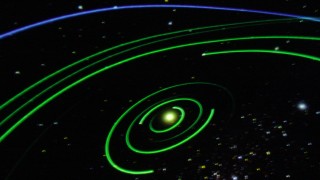
Astronomers have discovered the oldest planetary system ever found. The prehistoric star has five planets orbiting around it and the scientists has estimated that system to be around 11.2 billion years of age according to the L.A. Times.
Up until the present time, astronomers had been uncertain if stony planets would have been able to have formed such a long period ago. That would have been when the universe was five times younger than the age it is now. Scientists know for sure now that rocky type planets did form. They have written about it in a new study published in the Astrophysical Journal.
The discovery also proposes that there could have been ancient life in the universe and that it is much more likely than has ever been believed before, states astronomer and professor Dr. Sarbani Basu, who works at Yale. He explains that the find suggests that the planets were possibly like Earth at one time because they exist in the habitable zone. That means there could have been ancient life there as well.
The prehistoric star has been labeled Kepler 444 and is considered cool and small when compared to the Sun. It has only about 75 percent of Earth’s mass and is positioned just over 115 light years from Earth, inside the Milky Way Galaxy.
The five planets that are orbiting around it are somewhat smaller than Earth. They are believed to be between the sizes of Mercury and Venus. They all rotate swiftly around their host star and make complete orbits in under 10 days. Due to their sizes, astronomers think they each are probably rocky.
It was not until three years ago that scientists knew planets could form around such primordial stars. Kepler 444 is believed to have been created during an early era of the universe, when elements that were heavier than helium and hydrogen were much scarcer than they were when the Sun was formed 4.6 billion years ago.
Dr. Basu exclaimed that the Big Bang created only helium and hydrogen and all other elements, what scientists call “metals,” were formed inside of stars. She added that with each generation, metals in the universe increase. The detail alone that Kepler 444 is a low metal star just helps to reinforce that it is a very old one.
Due to the fact that heavy metals such as iron are considered to be the building blocks of rocky planets, astronomers thought that planetary systems would be uncommon around ancient stars but that did not appear to be the circumstance.
“The discovered system does not have only 1 planet but 5 of them,” explained Dr. Tiago Campante, who works as a researcher at a university in the United Kingdom and is also one of the lead authors of the paper. He stated that the newly found system might not be so rare.
De. Campante declared that in order to understand the planetary system, astronomers had to first try to understand the host star. In order to do that they had to rely on information taken by NASA’s Kepler spacecraft, which took images of the star one time a minute for four years, observing small variations in the brightness of the star.
This permitted them to spot every one of the five planets, because the star’s brightness dimmed just a tiny bit each time one of the planets moved in front of it. The information also allowed scientists to examine the natural reverberation of the star by using a technique known as asteroseismology. When observing the distinguishing frequency at which it pulsated, asteroseismologists were able to derive the exact stellar density, radius, age and mass of the old star.
In this study, numerous different asteroseismology teams evaluated data over Kepler 444, and they each arrived at the same conclusion that the star was around 11.2 billion years old. The five planets that are in orbit around Kepler 444 are considered to be too close to their host star to host any kind of life as human beings would know it in the present day, but the study has opened up the prospect that a planet similar to Earth that contained life might have existed in the early times of the universe.
Kepler 444 is believed to have come from the first generation of stars, so this planetary system tells astronomers that planets were forming around stars approximately 7 billion years before the Earth’s own solar system.
Image Credit - Zen Sutherland - Flickr License
